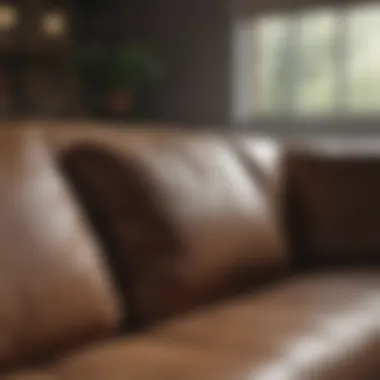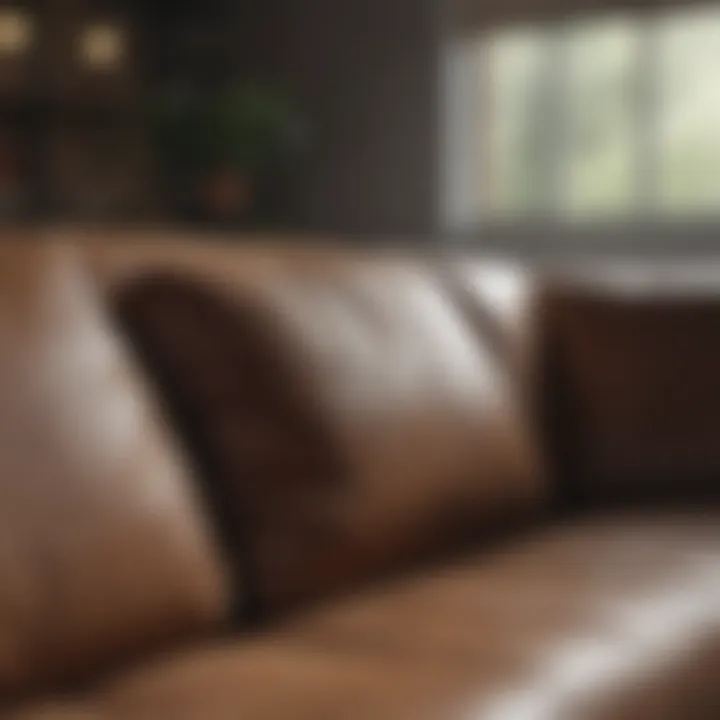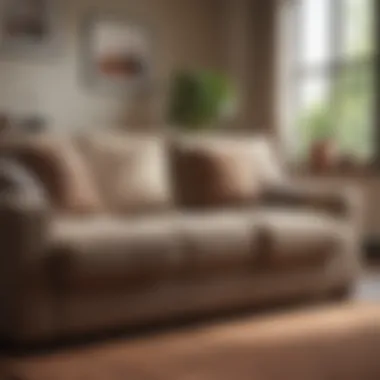Cleaning Products for Microfiber Couch: A Guide


Intro
Maintaining the appearance and cleanliness of microfiber couches is vital for any homeowner or design enthusiast. These pieces of furniture not only enhance the aesthetic of a space but also require specific care to ensure longevity. This guide will uncover a range of cleaning products suitable for microfiber upholstery, exploring their effectiveness and application methods. By understanding the nuances of microfiber care, readers can make informed choices to preserve their valuable investment.
Design Inspiration
Trending Styles
Microfiber couches come in various designs, from minimalist styles to plush, contemporary looks. Current trends often favor neutral tones and streamlined silhouettes, making them adaptable to any interior aesthetic. Whether one prefers a more cozy, inviting space or a sleek, modern environment, there's a microfiber couch design that will fit perfectly.
Color Palettes
Color plays a crucial role in interior design. Popular palettes range from soft grays and beiges to richer hues like navy or forest green. Choosing a color that complements the surroundings is essential. For families with children or pets, darker shades can often hide stains better, while light colors may require more frequent cleaning but can create a bright, airy atmosphere in a room.
Practical Tips
Maintenance & Care
To maintain the integrity of microfiber couches, regular care is paramount. Here are some practical steps to ensure longevity:
- Vacuum Regularly: Use a soft brush attachment to remove dust and debris.
- Spot Clean Immediately: Address spills and stains without delay using appropriate cleaners.
- Avoid Excessive Water: Microfiber can become discolored if soaked.
By adhering to these tips, maintaining a microfiber couch becomes manageable, keeping it looking fresh and inviting.
Budgeting & Planning
Cleaning products can vary significantly in price. For budget-conscious consumers, consider creating a simple plan:
- Research Affordable Cleaners: Check local stores or online retailers for suggested products.
- Test Before Committing: Try smaller sizes of cleaners if possible. They are less risky if they do not perform well.
- Consider Homemade Options: Simple ingredients like vinegar and baking soda can be effective in many cleaning scenarios.
Implementing a practical approach towards budget will ensure caregivers maintain their couch while also being cost-effective.
"Regular maintenance can extend the life of your microfiber furniture many years."
By approaching cleaning with a systematic mindset, maintaining a stylish and clean microfiber couch becomes an achievable task.
Understanding Microfiber Fabric
Understanding microfiber fabric is crucial when it comes to maintaining and cleaning your couch. Microfiber is a unique material that combines fine synthetic fibers, primarily polyester and nylon. This composition gives microfiber its renowned softness and durability, making it a popular choice for upholstery. Knowing the characteristics of this fabric can significantly influence your cleaning approach and help you preserve the integrity of your furniture.
What is Microfiber?
Microfiber is a textile made of extremely fine fibers, smaller than one denier. This means more fibers can be woven into a fabric, leading to a dense, plush texture. The first use of microfiber began in the late 20th century, gaining popularity due to its effectiveness for cleaning and soft touch. When it comes to couches, microfiber is often praised for its luxurious feel as well as its stain-resistant qualities. It is crucial for homeowners to recognize that while microfiber is resilient, it is also prone to staining if spills and dirt are not addressed promptly.
Properties of Microfiber
Microfiber possesses several properties that enhance its appeal for upholstery:
- Stain Resistance: Microscopic fibers can repel moisture and resist stains, making it easier to maintain clean surfaces.
- Durability: The fibers are strong and can withstand wear and tear, extending the life of the furniture.
- Breathability: Microfiber allows for air circulation, helping to avoid overheating during use.
- Easy to Clean: Many cleaners are compatible with microfiber, which helps in maintaining its appearance.
- Allergen Resistance: Microfiber can trap dust and allergens, creating a cleaner living environment when regularly maintained.
"Understanding the properties of microfiber helps in selecting the right cleaning approach to maintain its condition over time."
Common Challenges in Cleaning Microfiber
Cleaning microfiber couches presents unique challenges that can complicate routine maintenance. Understanding these common issues is essential for homeowners and design enthusiasts to avoid potential damage and maintain the aesthetic appeal of their furniture. The microfiber fabric, while durable and resistant to staining, still encounters problems such as accumulation of dust and allergens as well as stubborn stains. Addressing these challenges not only preserves the fabric's look but also supports a healthier living environment, making the entire cleaning process more effective.
Stains and Spots
Stains and spots are among the most prevalent challenges faced by microfiber couch owners. Various substances like food, beverages, or ink can leave lasting marks when they come in contact with the fabric. Microfiber, being a synthetic material, tends to attract and hold onto these substances, making them more noticeable compared to other upholstery types.
A common misconception is that water can resolve all staining issues, but this approach often exacerbates the problem, leading to a larger stain. Instead, specific cleaning products should be identified based on the type of stain. For example, oil-based stains may require solvent-based cleaners, while water-based stains may respond better to gentle hydrogen peroxide solutions.
Some general tips for tackling stains include:
- Act Quickly: The sooner you address a stain, the easier it will be to remove.
- Use a Blotting Technique: Always blot stains instead of rubbing them, as this reduces the risk of spreading the stain.
- Test Cleaners First: Before applying any product, conduct a small spot test to avoid further discoloration.
Dust and Allergens


Dust and allergens can accumulate on microfiber couches, which may pose health considerations. Microfiber is known for its textile fibers that can trap allergens like dust mites and pollen, creating an unhealthy indoor environment. This is particularly concerning for those with allergies or respiratory issues. Regular cleaning can mitigate these effects, but choosing the right cleaning technique and product is crucial.
Methods to address dust and allergens include:
- Regular Vacuuming: Employ a vacuum with a soft brush attachment to gently remove surface dust and dirt without damaging the fabric.
- Use Anti-Allergen Sprays: Some specialized sprays can neutralize allergens without harmful residues, ensuring a safer environment.
- Consider Professional Cleaning: For deeper cleaning, professional services can effectively remove dust and allergens, enhancing the lifespan of the upholstery.
"Microfiber fabric requires careful attention during cleaning, especially concerning stains and allergen buildup. Proper techniques can significantly improve the longevity of your furniture."
In summary, addressing the common challenges related to stains and allergens is vital for maintaining microfiber couches. A proactive approach through regular cleaning and the use of suitable products will ensure that your couch remains not only visually appealing but also safe and healthy for everyday use.
Types of Cleaning Products
Cleaning products are crucial when it comes to maintaining the integrity and appearance of microfiber couches. The right cleaners not only help to remove dirt and stains but also preserve the fabric's texture and color over time. Understanding the different types of cleaning products available allows homeowners to make informed decisions that best suit their cleaning needs. Each category has its unique advantages and considerations, which we will explore in detail.
Water-based Cleaners
Water-based cleaners are popular for their convenience and effectiveness. They generally consist of a mixture of water and various detergents or surfactants. These cleaners are gentle on microfiber but still provide enough cleaning power to tackle common stains. One of the primary benefits of using water-based cleaners is their ability to dry relatively quickly, minimizing adverse effects on the fabric.
Benefits of Water-based Cleaners:
- Gentleness: They are less likely to damage the microfiber fibers compared to harsher chemical solutions.
- Ease of Use: Most water-based cleaners can be used with simple spray and wipe techniques.
- Low Odor: Many options have minimal scent, making them suitable for indoor use.
However, it is essential to avoid oversaturating the fabric when using these cleaners. Excess water can lead to mold growth or water stains, undermining the advantages of using this cleaning method.
Solvent-based Cleaners
Solvent-based cleaners are another option for homeowners dealing with tougher stains. These cleaners use chemicals that can dissolve oils, grease, and other challenging substances. They are often more effective for deep stains that typical water-based cleaners might miss. However, caution is needed when using these types of products.
Considerations for Solvent-based Cleaners:
- Effectiveness: They tend to work faster and are more aggressive, providing a deeper clean for stubborn stains.
- Volatile Organic Compounds (VOCs): Many solvent-based products emit VOCs, which can be harmful indoors and may require proper ventilation during use.
- Potential Fabric Damage: They can sometimes cause discoloration or damage if not tested beforehand.
Using solvent-based cleaners might necessitate specific application techniques to prevent adverse effects on the microfiber.
Foam Cleaners
Foam cleaners offer another dimension in cleaning microfiber upholstery. They are often formulated as aerosols that expand upon contact, allowing the cleaner to penetrate the fibers effectively. This type of product can be particularly useful for surfaces that require a deeper clean without soaking the fabric thoroughly.
Advantages of Foam Cleaners:
- Controlled Application: The foam allows for pinpoint targeting of stains, reducing the risk of oversaturation.
- Quick Drying: Foam products typically dry faster than traditional liquid cleaners due to their non-liquid nature.
- Versatility: These cleaners can be used for both spot cleaning and larger sections of upholstery.
Eco-friendly Alternatives
In recent years, eco-friendly cleaning solutions have gained popularity among consumers. These products prioritize the health of both users and the environment, often using natural ingredients rather than synthetic chemicals. Eco-friendly alternatives can provide effective cleaning solutions while being less harmful to the fabric and surroundings.
Benefits of Eco-friendly Alternatives:
- Healthier Choices: They reduce exposure to harsh chemicals, making them better for sensitive individuals or families with children and pets.
- Sustainability: Many brands focus on sustainable practices in their ingredient sourcing and packaging.
- Effectiveness: Contrary to the misconception, many eco-friendly products perform just as well as traditional cleaners when used correctly.
Choosing the right type of cleaning product is essential for effective maintenance of microfiber couches. Each category has its unique benefits and should be selected based on specific cleaning needs and personal preferences.
How to Choose the Right Cleaning Product
Selecting the appropriate cleaning product for your microfiber couch is a crucial step in maintaining its appearance and longevity. Each product type has unique characteristics and effectiveness, depending on the specific stains or dirt encountered. Understanding these nuances is essential for homeowners, as using the wrong product could result in damage or inadequate cleaning, leading to frustration.
Understanding Fabric Care Labels
Fabric care labels provide critical information about the cleaning requirements of your microfiber couch. These labels often include symbols and instructions indicating the cleaning methods that are safe to use. There are typically three main symbols:
- W: This means that water-based cleaning solutions are safe to use.
- S: This indicates that solvent-based cleaners should be utilized.
- WS: A combination of both water and solvent-based cleaners is appropriate.
By adhering to the guide provided on the care label, you minimize any risk of harming the fabric. Always examine these labels closely before choosing a product, as they can prevent mishaps and keep your upholstery looking fresh.
Assessing Cleanliness Needs
Determining the specific cleanliness needs of your microfiber couch is a vital step in the cleaning product selection process. Not all stains require the same approach, and understanding the type of dirt or blemish affecting your couch is helpful. Consider the following factors:
- Type of Stain: For example, grease and oil stains call for different cleaning agents than water-based stains like coffee or juice.
- Frequency of Use: A couch that endures heavy use may need more regular and thorough cleaning than one that is used less often.
- Presence of Allergens: If your household experiences allergies, consider a cleaning product that addresses allergens and dust, particularly if the couch is a significant source of these particles.


In assessing these aspects, homeowners can better select product types that will effectively address the unique challenges presented by their microfiber couches. Taking these considerations seriously can extend the life of the fabric while ensuring that its aesthetic appeal remains intact.
Application Methods for Cleaning Microfiber
Understanding the best application methods for cleaning microfiber is crucial for maintaining your couch’s appearance and longevity. Microfiber, being a synthetic fiber, requires specific approaches to avoid damage while effectively removing dirt and stains. Choosing the right method not only preserves the fabric but also ensures your cleaning efforts produce the desired results without causing further issues.
Spot Cleaning Techniques
Spot cleaning is often the first approach taken for minor stains and spills. This method targets specific areas rather than subjecting the entire sofa to a cleaning process. Here’s how to do it properly:
- Act Quickly: Time is of the essence. The sooner you treat a stain, the easier it will be to remove.
- Use a Soft Cloth: An absorbent, soft cloth or sponge is essential. Avoid rough materials that could cause fraying or damage to the microfiber fibers.
- Damp, Not Wet: Lightly moisten the cloth with water or your chosen cleaner. Too much liquid can lead to over-saturation, making the stain worse or causing watermarks.
- Blot, Don’t Rub: Gently blot the stained area. Rubbing can push the stain deeper into the fibers.
- Rinse: If you used a cleaner, rinse the area with a dry cloth to remove any residue.
By using these techniques, you preserve the texture and appearance of the couch while efficiently dealing with small mishaps.
Deep Cleaning Approaches
Deep cleaning is necessary for periodic maintenance, especially if your couch has accumulated dirt over time or has deeper stains. Here are some recommended approaches:
- Steam Cleaning: This method utilizes steam to penetrate the fibers, effectively loosening dirt without the need for harsh chemicals.
- Upholstery Cleaners: Choose a cleaner specifically designed for microfiber. Apply it using a soft-bristle brush to agitate the fabric gently.
- Shampooing: Upholstery shampoos designed for microfiber can provide excellent results. Follow the manufacturer's instructions carefully, ensuring not to over-saturate the fabric.
Consider scheduling deep cleaning every six to twelve months, depending on usage. This prevents buildup and maintains a fresh appearance.
Using Upholstery Cleaners
Upholstery cleaners are a broad category, with various options available on the market. Here are key points to consider:
- Choose Wisely: Not all cleaners are suitable for microfiber. Look for cleaners labeled as safe for synthetic upholstery.
- Read Labels: Pay attention to the instructions regarding dilution, if applicable, and any specific guidelines on application methods.
- Test First: Before applying any cleaner, conduct a spot test in an inconspicuous area of the couch. This ensures the cleaner will not adversely affect the color or texture.
Using the right upholstery cleaner allows you to address stubborn stains effectively while maintaining the integrity of microfiber fabric.
Always prioritize product safety; using harsh chemicals can deteriorate microfiber and may void warranties.
Maintaining Microfiber Couches
Maintaining microfiber couches is crucial for preserving their aesthetic appeal and prolonging their lifespan. Microfiber is known for its durability and resistance to wear, but it still requires regular maintenance to keep it looking pristine. Proper care can enhance the fabric’s texture and visual quality, ensuring that your investment remains valuable over time. Regular upkeep helps prevent dirt buildup, dispels allergens, and can ultimately save money on professional cleanings down the line.
In this article, we will delve into two main aspects of maintaining microfiber couches: routine cleaning practices and preventative care strategies. Understanding how to clean and care for your microfiber upholstery effectively ensures that it can withstand daily use while retaining its original charm.
Routine Cleaning Practices
Routine cleaning practices are essential for maintaining the freshness of your microfiber couch. Daily maintenance can be simple and often does not require the use of harsh chemicals. Here are some effective practices:
- Vacuum Regularly: Using a vacuum cleaner equipped with a brush attachment helps remove dirt and dust before it settles into the fabric. Aim to vacuum your couch weekly to keep it clean.
- Spot Clean Immediately: Accidents happen. When spills occur, it's advisable to clean them promptly to prevent staining. Use a soft, damp cloth or sponge to blot the area, avoiding harsh rubbing that can damage the fibers.
- Use a Soft Brush: Detangling the fibers can keep your couch looking soft and plush. A soft brush can lift dirt and crumbs without causing harm. Make this a part of your weekly routine.
Implementing these simple cleaning habits can significantly reduce the effort needed for deep cleaning while keeping your microfiber couch looking new.
Preventative Care Strategies
Preventative care strategies can greatly enhance the longevity of your microfiber couch. These strategies focus on protecting the fabric from stains and damage before they occur. Consider these approaches:
- Use Fabric Protector: Applying a fabric protector sprays can create a barrier against spills and stains, making cleaning easier in the future. Ensure the product is suitable for microfiber before application.
- Arrange Furniture Wisely: Position your couch away from direct sunlight to prevent fading. Furthermore, aim to create a layout that minimizes wear on the fabric, avoiding heavy traffic areas.
- Cover with Throws or Blankets: Use decorative throws or blankets over the couch during events or gatherings. This extra layer can protect against spills, pet hair, and any other potential damage.
- Rotate Cushions: To avoid uneven wear, rotate and swap cushions periodically. This practice can help maintain the structure and look of the couch over time.
By controlling the environment around your microfiber couch and using protective measures, you can ensure its appearance and functionality are preserved, ultimately extending its life.
In summary, maintaining microfiber couches involves both routine cleaning practices and preventative care strategies. These efforts contribute to the overall health of the fabric and can significantly enhance the enjoyment of your upholstery.
Dealing with Specific Stains
Cleaning microfiber couches is a nuanced task, especially when it comes to dealing with specific stains. Understanding the different kinds of stains that can occur is essential for effective cleaning. Stains can ruin the appearance of your couch and may even lead to permanent damage if not treated correctly and promptly. Therefore, being knowledgeable about common types such as ink marks, food spills, and grease spots is crucial.
Ink and Pen Marks
Ink stains can be particularly stubborn on microfiber. When a pen leaks or you accidentally mark the fabric, the dark pigment can penetrate the fibers. To treat ink stains effectively, act fast. First, dab the area gently with a clean, dry cloth to absorb excess ink. Avoid rubbing, as this spreads the stain. Then, use a small amount of isopropyl alcohol on a cotton ball or cloth. Test it on a hidden area to ensure it won't damage the fabric. Once verified, lightly dab the stained area with the alcohol-soaked cotton. This process can help break down the ink without harming the microfiber material.
Food and Beverage Spills
Food or beverage spills are a common occurrence, especially in households with kids or frequent entertaining. It’s essential to address these spills quickly to prevent them from setting into the fabric. Start by blotting the spill with a clean, dry paper towel to soak up as much liquid as you can. After blotting, mix a solution of warm water and mild dish soap. Dampen a clean cloth with the soapy water and gently dab the stained area. Rinse with just water and use another clean cloth to blot dry. This method keeps your couch looking fresh and prevents stains from becoming permanent.
Grease and Oil Stains


Grease stains can be one of the toughest challenges when cleaning microfiber. The slippery nature of oils can make these stains spread if not handled correctly. Begin by sprinkling cornstarch or baking soda on the stain. Both natural absorbents will help lift the oil away from the fibers. Leave it on for at least 15 minutes before vacuuming it up. After that, clean the area with a solution of warm water and a few drops of dish soap. Rinse with clean water and blot dry. This method often restores the couch to its original state while minimizing the risk of damage.
"Quick response to stains is key in maintaining your microfiber furniture's integrity."
Understanding how to treat specific stains effectively not only helps in preserving the appearance of your couch but also extends its lifespan. By employing the proper methods tailored to each type of stain, you can ensure a cleaner, well-maintained living space.
Testing Cleaning Products
Testing cleaning products is an essential step in maintaining the quality of microfiber couches. The variety of cleaning agents available can lead to uncertainty about their effects on fabric. Each cleaner may perform differently based on its chemical composition, making testing critical to avoid damaging the upholstery.
The primary benefit of testing cleaning products lies in ensuring the safety and compatibility of the cleaner with your specific microfiber fabric. Not all microfiber materials are the same, and some may react poorly to certain chemicals. Therefore, testing helps identify any adverse reactions before applying a cleaner to the entire surface.
When testing products, consider the following key elements:
- Effectiveness: Determine if the product effectively removes stains and dirt.
- Compatibility: Ensure the product does not cause discoloration or fabric damage.
- Odor: Check if the cleaner leaves an undesirable scent on the fabric.
By performing tests, homeowners can confidently choose effective cleaning solutions suitable for their microfiber couches, mitigating the risk of costly mistakes.
Spot Testing Techniques
Spot testing involves applying a small amount of the cleaning product to an inconspicuous area of the couch. This technique allows homeowners to observe the product's effect without risking the overall appearance of the upholstery. Here are the steps to carry out spot testing effectively:
- Select a Hidden Area: Choose a location that is not easily visible to the eye, such as the back or underside of the couch cushion.
- Apply the Cleaner: Use a clean cloth or cotton swab to apply a small amount of the product.
- Observe Changes: Allow the cleaner to sit for a short period, then check for any discoloration or damage to the fabric.
- Clean the Test Area: If no adverse effects are observed, proceed to clean that area genuinely.
This method is simple yet effective, protecting the integrity of your couch while ensuring the cleaning product is appropriate.
Timing and Wait Periods
Timing is also crucial when testing cleaning products. Different products have varying recommended wait periods for optimal effectiveness. Following the manufacturer's guidelines allows the product to work as intended. Here are some general tips on timing and wait periods:
- Follow Instructions: Always adhere to the recommended time stated on the product label for optimal results.
- Check for Reactions: After the specified wait period, inspect the test area for any changes before moving to larger sections.
- Reapply if Necessary: If the initial results are not satisfactory, you may need to reapply the product but allow more time for it to act.
Utilizing proper timing ensures that homeowners can maximize the benefits of their cleaning products while preserving the appearance of their microfiber couches.
Common Mistakes in Cleaning
In the realm of home care, understanding how to clean microfiber couches effectively goes beyond the selection of cleaning products. The methodologies employed can greatly influence the longevity and appearance of the fabric. Common mistakes typically stem from a lack of knowledge or misconceptions. Recognizing these issues allows homeowners to preserve their investment. This section addresses two critical errors: over-saturation with water and the usage of harsh chemicals. By understanding these pitfalls, one can ensure their microfiber furniture remains in optimal condition.
Over-saturation with Water
One prevalent mistake when cleaning microfiber couches is the over-application of water. While microfiber is designed to be durable and withstand cleaning, excessive moisture can have adverse effects. When you saturate the fabric, it can lead to water stains, promote mildew growth, and cause the fibers to become misshapen.
Using a damp cloth is recommended, but ensure it is not dripping. It’s crucial to test your method in a concealed area before proceeding with the entire surface. Allowing the couch to dry properly after spot cleaning prevents lingering moisture which can negatively impact the fabric.
Using Harsh Chemicals
The second critical error involves employing harsh chemicals on microfiber. Many household cleaning products contain strong solvents which can damage the soft surface of microfiber. Products with bleach or ammonia can strip the fibers, leading to discoloration and a loss of texture.
Instead, opt for cleaners labeled specifically for microfiber. If you prefer DIY solutions, consider mixing mild soap with water. It effectively tackles dirt without compromising the integrity of the fabric. Always remember to perform a spot test before fully applying any cleaner.
Both over-saturation and the use of harsh chemicals can severely limit the lifespan of your microfiber couch.
In summary, avoiding these mistakes ensures your couch retains its original beauty and functionality. Proper care practices lead to fewer repairs and a better overall aesthetic for your living space.
Final Thoughts on Cleaning Microfiber Couches
Cleaning microfiber couches is an essential part of maintaining their appearance and longevity. This section consolidates the efforts discussed throughout the article, emphasizing the best practices and considerations homeowners and design enthusiasts should keep in mind. Proper care is not only about aesthetics but also about preserving the functionality of the fabric. Understanding what products work best and the methods to apply them can significantly enhance the durability of microfiber upholstery.
Summary of Best Practices
To maintain a microfiber couch effectively, incorporate these best practices:
- Regular Vacuuming: Dust and debris accumulate on the surface, leading to a dull appearance. Regular vacuuming keeps microfibers looking fresh.
- Spot Cleaning Quickly: Address spills and stains promptly using a suitable cleaner to prevent permanent damage.
- Use Approved Products: Stick to water-based or specifically formulated cleaning products designed for microfiber. Harsh chemicals can break down the fabric fibers over time.
- Avoid Over-Saturation: Too much cleaning solution or water can soak the couch, causing mold or mildew growth. Use a damp cloth instead of soaking the surface directly.
- Test Products: Always perform a spot test on a hidden area of the couch before applying a new cleaning solution widely.
Maintaining these habits ensures that your microfiber couch will age gracefully, looking appealing for years.
Long-term Care Considerations
Long-term care involves more than just cleaning. Here are key considerations:
- Fabric Protection: Consider using a fabric protector designed for microfiber. It can help repel stains and spills, making cleaning easier in the future.
- Periodic Professional Cleaning: Every few years, hiring a professional upholstery cleaner can refresh the entire couch, removing deep-seated dirt and restoring its original look.
- Avoid Direct Sunlight: Placing your couch in areas where it won’t be exposed to harsh sunlight will prevent fading and deterioration of the fabric.
- Rotate Cushions: Rotate the cushions regularly. This promotes even wear and helps maintain their shape.
"Proper care and maintenance of microfiber couches not only beautifies your living space but also extends the life of your investment."
By being proactive and following these considerations, you can ensure your microfiber couch remains a feature piece in your home, enhancing comfort and style.















